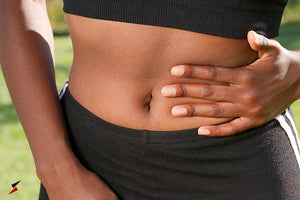What is abdominal separation or Diastasis Recti Abdominis (DRAM) ?
Many medical professionals compare pregnancy to running an ultra-marathon.
DRAM or abdominal separation is a condition that is commonly seen during and after pregnancy as a gap of roughly 2.7cm or greater between the two sides of the rectus abdominis. Some refer to it as “jelly belly” or “mummy tummy”- the condition can be very painful and sometimes last for many months.
Abdominal separation occurs when the growing uterus causes the 2 long parallel muscles of your stomach to separate from each other. These muscles run from your chest to your pelvis, just under the skin, down the middle of your belly.
The condition is partly due to the pressure of your growing baby and partly due to the hormonal changes that take place during pregnancy. It usually starts in the second half of pregnancy.
Abdominal separation is more common in women who have had more than 1 child, are aged over 35 or who are having twins or triplets (or more). It can also occur in smaller women who have a larger-than-average baby.
53% of women suffer from Diastasis Rectus Abdominus Muscle (DRAM) separation postpartum and 36% of those remain abnormally wide after 5-7 weeks.2
How do you know if you have abdominal separation?
You may be able to see a gap between the two bands of abdominal muscles. You can see this gap more clearly if you lie flat on your back and lift your head up.
You might also notice a bulge in the middle of your stomach, especially when your abdominal muscles are active.
Many women with abdominal separation also get lower back pain, as the separation prevents the stomach muscles from supporting the back.
How can you diagnose abdominal separation?
Your GP, obstetrician or physiotherapist can assess your abdominal separation by measuring it with their fingers or a measuring tape, or by doing an ultrasound.

How can abdominal separation be prevented during pregnancy?
Strengthening your core muscles before you are pregnant or in the early stages of pregnancy can help prevent abdominal separation.
It’s best to avoid putting excess strain on your abdominal muscles while pregnant. Avoid sit-ups or planks.
How is abdominal separation after the birth treated?

It’s important to stop the separation from getting worse. Try these tips:
- Avoid lifting anything heavier than your baby.
- Roll onto your side when getting out of bed or sitting up.
- Choose gentle exercises (rather than intense ones) that strengthen the deeper stomach muscles.
- Avoid movement that can make abdominal separation worse, such as sit-ups , oblique curls and some yoga poses (ask your GP or physiotherapist for advice).
You can also wear a functional postpartum compression short or leggings - https://supacore.com/collections/pre-post-natal- to help support your back, stabilize your pelvis and help engage your core muscles.
Will some good compression and specific exercise regime with your physiotherapist there is a good chance that the muscles will come back together.
For some women surgery is necessary – this often involves using stitches to repair the abdominal wall and reduce the gap between the muscles. This can improve quality of life and muscle strength, especially when separation is wider than 3cm.
References
Correlation between Diastasis Rectus Abdominis and Lumbopelvic Pain and Dysfunction. Khushboo D,
Amrit K, Mahesh M.2014
2Spitznagel T, Leong F, Van Dillen L, Int. Urogyn J. 2007 Vol 18(3):321-328
1 Harms, M.D., Roger W. "Why do abdominal muscles sometimes separate during pregnancy?".


